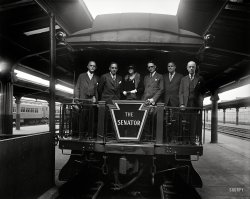
MAY CONTAIN NUTS

Search Shorpy
SHORPY ART

Framed or unframed, desk size to sofa size, printed by us in Arizona and Alabama since 2007. Explore now.
Join and Share
Ad-Free Shorpy
Shorpy is funded by you. Patreon contributors get an ad-free experience.
Learn more.

Recent comments
- Yellow sky at morning
- Side Winder
- Air Quality?
- Sojourner Truth riot
- None were so blind(ed)
- The less famous sister
- Good ol' days?
- Rise and Fall
- Goo Goo Ga Joob
- Ticket Retention
- Not the only one
- Vagaries of War
- Killed by Amtrak
- Back to the Future
- Wanted --
- If you can't stand the light
- Centralized Traffic Control, I believe
- What's really happening
- Heckuva remote control!
- Sometimes — Things Go Bump!
- I SEE THE LIGHT
- Union Switch and Signal Company
- Get That Light Out Of My Eyes
- Eggs. Eggs. Eggs. The Egg Man is Here!
- Foreboding caption
- Famous Hollywood faces
- Not just S&P
- re: Those things in the jar
- Up In Smoke
- Medical Smoking
Member Photos
The Shorpy
Print Emporium
Print Emporium
Search Shorpy
Search results -- 30 results per page
- My Little Pony: 1918
- ... up to be a registered nurse. She died by her own hand in 1955 at the age of 45. View full size. 5x7 glass negative, George Grantham ... Posted by Dave - 08/19/2012 - 3:03pm -
![My Little Pony: 1918 New York, July 22, 1918. Alice de Goicouria Belmont on "Beauty." Alice, the daughter of August Belmont Jr. and an heir to the Belmont banking fortune, grew up to be a registered nurse. She died by her own hand in 1955 at the age of 45. View full size. 5x7 glass negative, George Grantham Bain Collection.
Go Ask AliceLet this be a lesson, ponies do not lead to happiness.
Who wouldn't love a pony?Now we know!
BeautyDoes anyone know what breed of pony Beauty might be?
The Wedding of Alice's ParentsOne of the smartest, but smallest, weddings of the Winter took place yesterday afternoon in the Church of the Ascension when Miss Alice de Goicouria, younger daughter of Albert de Goicouria, was married to August Belmont, Jr., elder son of August Belmont.
Both families were in mourning at the time of the wedding, she for her mother and he for his uncle. It is noted that the bride wore her veil in a "totally new fashion."
NY Times 1906
History appears to be silent on the subject of Alice the younger.
[Alice was an aspiring musician whose artistic ambitions were thwarted by her family. More later. - Dave]
A little unhappyShe doesn't seem too thrilled at this age, either.
(The Gallery, G.G. Bain, Horses, Kids, NYC)](https://www.shorpy.com/files/images/27279u1.thumbnail.jpg)
- Now Playing: 1920
- ... up, and is the first place I ever saw a movie, when in 1955 my grandmother took me to see an Abbott and Costello picture there. I hope ... Posted by Dave - 07/17/2012 - 10:16pm -
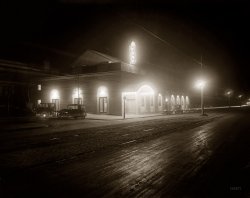
- Tailgater: 1943
- ... All of the 128 locomotives of this class were gone by 1955.
Minor Refinement to Location Great photo! The location is where ... Posted by Dave - 04/25/2015 - 9:35pm -
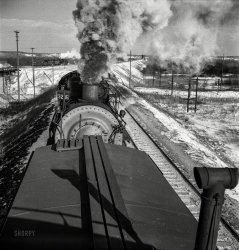
- Mowing the lawn
- ... and the red station wagon across the street is a 1956 or 1955 Ford (Fairlane) Country Sedan station wagon. I do think it's a '56 though. ... Posted by Tony W. - 09/20/2011 - 8:24pm -
![Mowing the lawn Mowing the lawn was a family experience back then. I really like the car in the back (I'm not a car enthusiast. What kind of car is that?). Why don't cars come in that color anymore? It's kind of funny because the little kid, my father, later grew up to become a chief engineer on tuna boats. This was taken in L.A., early '60s. Scanned from a Kodak safety negative. View full size.
Ford FalconThe car is either a 1962 or 63 model. My grandfather had one in white.
1961 FalconI checked around--the car is a 1961 Ford Falcon--note the way the front bumper has a rise in it, around the license plate--that's the 1961 style. I owen a 1962 Falcon in red for a number of years. I gave the car to my sister,and the day I did, the gas tank sprang a leak in her parking lot! http://www.hubcapcafe.com/ocs/pages01/falc6101.htm
Even more obscure car IDFor real experts, what's the car at the extreme left edge? I want to say VW bug.
Tterrace's questionThe car in question is the one below.
[That's a Volvo. What a great photo! Wouldn't it look nice in the Member Gallery? - Dave]
Grateful tterraceExcellent! As a bonus, we get a '60 or '61 Rambler. I second Dave's gentle hint: this shot deserves a larger version.
[Click on pic. Voila. And viola. - Dave]
Starlight Blue, to be exact: The car directly behind your Grandpa is a '61 Ford Falcon (Deluxe) (told by the trim) and the color, according to the "AutoColorLibrary" is: "Starlight Blue".
Oh, and the *hint* of a taillight on the extreme left, TTerrace suggests it's the same Volvo 544 in the other pics.
Awesomeness, once again, Tony! Keep 'em coming!
Pickup and Wagon The truck is a 1961 Chevrolet Apache 10, with some crazy looking camper shell on it, and the red station wagon across the street is a 1956 or 1955 Ford (Fairlane) Country Sedan station wagon. I do think it's a '56 though.
(ShorpyBlog, Member Gallery, Kids, Tonypix)](https://www.shorpy.com/files/images/MowingtheLawn_0.thumbnail.jpg)
- Iron Butterfly: 1943
- ... to hit a "Caterpillar shovel" in 1945. It was scrapped in 1955.
(The Gallery, Jack Delano, Railroads) ... Posted by Dave - 10/18/2013 - 12:09pm -
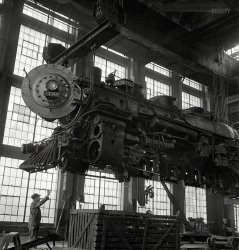
- Old-School: 1953
- ... WAS my elementary school. I went to kindergarten here in 1955. I was put into shock this morning when I woke up to this photo. Funny, ... Posted by Dave - 07/20/2015 - 10:17pm -
![Old-School: 1953 Jan. 29, 1953. "Greenville School, town of Greenburgh, New York. Foyer." At right, "Third Grade Paintings." 5x7 negative by Gottscho-Schleisner. View full size.
FamiliarI'm sure this looks familiar to Shorpyites of a certain age - it looks just like my elementary school in Michigan. Most of the 50's and 60's schools seemed to share the same DNA. Many of those windows were blocked off and insulated in the panic of the oil crisis in the '70s.
Natural Light EverywhereThe complete LOC set is fascinating. Love these midcentury school designs, with abundant natural light in classrooms--and windows that open!--very unlike classrooms in the school where I teach (built in the 1990's). For the nerdiest among us, here is an interesting history of school design 1900-present.
Academic AromasAhhh, the scent of a mid-century American elementary school. Our sense of smell and the way our brains organize memory (the olfactory bulb is part of the brain's limbic system) are very closely related; aromas can call up memories and powerful responses almost instantaneously. I guess it works in reverse, too, because seeing this school scene caused ghost scents to appear in my office this morning as I indulged my coffee and breakfast taco and Shorpy habits. The phantom aromas have to be strong to overpower a taco and cup of Ruta Maya…but here’s what I detected:
*The indigo dye in brand new blue jeans
*A whiff of Cavendish pipe smoke coming from the principal’s office
*Sweaty kids – not the sourly rank teen kind, but the innocent 4th grade kind
*Mimeograph ink
*Fish sticks and sheet cake from the cafeteria
*Wood shavings from the pencil sharpeners
*Bic pen ink
*Cardboard Duo-Tang folders
*Cut grass from the playground
*Crayola crayons and construction paper
*An olfactory stew of gum eraser, chalk dust, and Elmer’s glue
*Ms. Borcherding’s rose petal perfume and Aqua-Net hairpspray
And perhaps my most vivid olfactory memory: the faintest hint of “Charlie” perfume, booze and cigarette smoke wafting around the hot-before-I-knew-what-hot-was library assistant Ms. Sherri D’Amato (Cherry Tomato).
Goober Pea
Re: Academic AromasOne more: that green stuff the janitor threw on the floor before he swept.
ackModernist architecture and, yes, I went to schools very similar to this. They were, like most modernist designs, stiff, cold, and boring.
In this picture, gaze with head shaking at the Danish modern furniture, which I think was designed to be as uncomfortable and unattractive as possible.
Thank you. It's good to get that off my chest!
More than familiarThis doesn't look like my elementary school, this WAS my elementary school. I went to kindergarten here in 1955. I was put into shock this morning when I woke up to this photo. Funny, the only thing I remember were the naps. My brother went there too.
Hey, that's my schoolWhat a surprise today at my daily glimpse of Shorpy as I saw "my" Greenville School where I attended second through fourth grades from 1950-54. That Shorpy would single out such a relatively insignificant school in of all in the country seemed a bit strange so I did a double take to see that it was actually "my" Greenville School. Although I walked past the furniture in the foyer every day, my memory does not recall it after 62 years, yet that memory clearly remembers riding rain, snow, or shine on a 1950 English 3-speed Rudge bicycle to school every day. I rode that Rudge through 1970 in college. The Greenburg area of Scarsdale was a wonderful place to grow up.
Strangely, it was a 1958 photo of my new Redwood High School in Larkspur, CA that was posted on Shorpy some years back that got me to looking at Shorpy every day. Great site and many memories.
[You're in my 1961 Redwood Log yearbook, your senior year, my freshman. I posted that 1958 Redwood photo my brother took. -tterrace]
My Thoughts Exactly, Gooberpea!Upon seeing this photo of what could've been my elementary school at Kincheloe AFB, Michigan I too was overwhelmed with "aromatic" memories. I giggled to myself while thinking, "I wonder if anyone else associates memories with smells", and all at once I read your post, Goober Pea. Apart from Ms. Cherry Tomato, you got it, exactly!
Academic Aromas IIMy elementary school had similar smells as Gooberpea mentioned except for Ms. Borcherding’s rose petal perfume and Aqua-Net hairpspray since mine was the Shrine of the Little Flower.
No parochial student of my era '46-'52 could ever forget the smell of a rainy Friday. There was the aroma of wet boys' cudoroy school pants mingled with the aromas of the brown bag Catholic lunches of that era. Hardboiled eggs, fried eggs, salmon croquettes, fried fish and for a lucky few crab cakes created a meatless miasma of unforgettable smells.
(The Gallery, Education, Schools, Gottscho-Schleisner)](https://www.shorpy.com/files/images/SHORPY-5a17424u.thumbnail.jpg)
- Virginia City With Cars: 1965
- ...
Crunch Time I wonder what the driver of the 1955 Mercury ran into that caved in the fender but spared the trim? Someone ... Posted by tterrace - 09/18/2018 - 10:54pm -
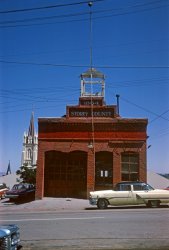
- Bowling Green: 1900
- ... light court. Alas, the Produce Exchange was demolished c. 1955 and replaced by the (to put it charitably) nondescript building called ... Posted by Dave - 12/11/2015 - 11:19am -
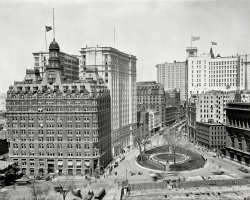
- Frank E. Kirby: 1910
- Toledo, Ohio, circa 1910. Sidewheeler Frank E. Kirby at steamer landing." 8x10 inch dry plate glass negative, Detroit Publishing Company. View full size.
Flyer of the Lakes Named to honor her designer, Frank E. Kirby, a naval archit ... Posted by Dave - 08/09/2012 - 1:20pm -
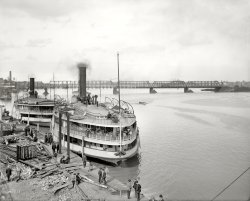
- A Room With a View: 1942
- ... on East 70th Street, however that wasn't built until 1955. It could have been a predecessor or might have been the hospital on the ... Posted by Dave - 07/16/2014 - 10:49am -
![A Room With a View: 1942 November 1942. "Babies' Hospital, New York. The welfare of this young patient, suffering from burns, is aided by having his bed placed near a window where he can watch the boats pass by. Nurses learn the importance of ministering the comforts of their patients in promoting recovery." Photo by Fritz Henle for the Office of War Information. View full size.
The Land of CounterpaneThe Land of Counterpane
When I was sick and lay a-bed,
I had two pillows at my head,
And all my toys beside me lay,
To keep me happy all the day.
And sometimes for an hour or so
I watched my leaden soldiers go,
With different uniforms and drills,
Among the bed-clothes, through the hills;
And sometimes sent my ships in fleets
All up and down among the sheets;
Or brought my trees and houses out,
And planted cities all about.
I was the giant great and still
That sits upon the pillow-hill,
And sees before him, dale and plain,
The pleasant land of counterpane.
- Robert Louis Stevenson
Milk sips, Greek shipI wonder what a ship of Occupied Greece was doing in New York.
[It's an American vessel. - Dave]
View To The BridgeI've been trying to figure out where this picture was taken. The view from the window reminds me of a visit I once made to The Hospital for Special Surgery on East 70th Street, however that wasn't built until 1955. It could have been a predecessor or might have been the hospital on the then Welfare (now Roosevelt) Island, which is in the East River between Manhattan and Queens.. I am beginning to believe it was Welfare Island. It is absolutely in The East River. The bridge in the background is the Triborough (now RFK) Bridge. The large building adjacent o the bridge, I believe is a city run psychiatric center on Randall's/Ward's Island near the Hells Gate Bridge. Roosevelt Island is east of East 70th street and its northern extension ends at about 85th Street.
That bridge -seems to me to be the 59th Street/Queensborough Bridge, rather than the Triboro/RFK Bridge. The Triboro is somewhat further north of Roosevelt Island, and unlike the Queensborough does not cross the island. It does, however, cross Ward Island/Randall's Island. The structure of the Queensborough is sort of a gothic truss, while the Triboro is a more graceful Art Deco suspension bridge.
Remembrance of things yet to come ...Reminds me definitively of my extended stay at the US Navy Hospital in Portsmouth, Virginia in December, 1976 for knee surgery. I was a new military dependent, having married a US Air Force Airman the previous July. I had a knee injury requiring surgery, and the hospital at the Air Force Base did not have enough facilities at the time to treat dependents. So I was sent to the Navy Hospital across the river, which being the oldest US Navy Hospital in existence, was/is quite up to the task. Oddly enough, I was treated by an Air Force Surgeon!
I was admitted to the Orthopedic Unit, which happened to be on the topmost floor of the facility, I'm thinking at least 12 stories, in the old building which has since been replaced by brand new facilities recently. I was fortunate enough to get the window side bed, overlooking the river where all the ships could be seen entering or leaving the harbor. At night, the view with all the lights was magnificent, and the TWELVE nights I spent there treated me to some views I will never forget.
(The Gallery, Boats & Bridges, Fritz Henle, Kids, Medicine, NYC)](https://www.shorpy.com/files/images/SHORPY_8b08095u.thumbnail.jpg)
- The Grayhouse: 1907
- ... collection to the City of Detroit and the Conservatory. In 1955 the Conservatory was dedicated to her."
My family, beginning with ... slides of the interior and exterior that were taken in 1955-56 can be found here.
Mom My mom told me stories of trips to ... Posted by Dave - 03/21/2014 - 11:35am -
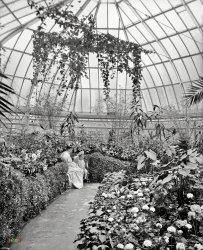
- Mrs. Ostermeyer: 1936
- ... "Family of Man" exhibition at the Museum of Modern Art in 1955. In the catalogue, it's on p. 79,
I am a decendent of this woman ... Posted by Dave - 09/09/2011 - 6:33pm -

- William G. Mather: 1905
- ... the J.H. Sheadle in 1925, then the H.L. Gobeille in 1955, and finally the Nicolet in 1965. She was scrapped in Port Maitland, ... Posted by Dave - 06/28/2013 - 8:58pm -
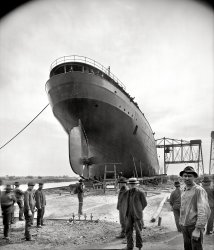
- Garage à Trois: 1940
- ... wrecking train that dismantled the Crested Butte branch in 1955. After that, #268 went on static display in Gunnison with a gaudily ... Posted by Dave - 04/27/2020 - 9:58am -
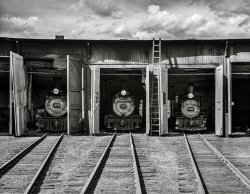
- Mystery 50s photo
- ... design is that of the 1951 California plate, used through 1955 with a metal year tab attached at the lower right for renewals. There ... Posted by Lady Ashmire - 08/17/2012 - 8:14pm -
![Mystery 50s photo Judging from the other photos in the box with this, these people are either relatives or childhood/family friends of my mother, which would mean the pic was most likely taken in Salt Lake City or possibly Albuquerque, those being the two cities where she grew up. Unfortunately, those who would know for sure are no longer alive to tell me. I just found it an interesting pic, as you don't seem to see photos of less-prosperous-looking people in this time period very often, also I thought some Shorpyites might have fun trying to identify the various vehicles in the background. View full size.
PackardThe most obvious car is a 1941 Packard. Given the two-tone paint, perhaps a taxi. The setting looks more like Albuquerque than Salt Lake City to me.
Railroad crossing/street trackageWhat appears to be a flag on the building in the background (white or silver "X" on a black background) is actually a railroad crossing sign suspended on a wire over the street, indicating a track running in the cross street at that location. These signs were common in California cities where street trackage existed, and the buildings look like southern California to me, too. There was also a lot of street trackage in Salt Lake City, much less if any in Albuquerque to my knowledge.
Not a TaxiYes, it is a 1941 Packard and it is a model 110 with a 6 cylinder 110 HP motor. You can tell because it has the smaller decorative trim in the center of the front bumper as opposed to the model 120 (8 cylinder - 120 HP)with a larger trim piece. The 160 and 180 models both had same front bumper and it was larger and distinctly different.
Two-tone colors were popular with Packards back in 1941 and the offered six, different combinations that year. And I don't see any taxi trim. I own two 1941 Packards, one a 120 and the other a 160.
License plate and locationI'm pretty sure the Packard's license plate is not from New Mexico or Utah. It has an early 1950s California look to it. The color (light on dark, probably yellow on black) fits 1950s California, but the number looks more like CA's 1940s pattern, except that in the 1940s the word "California" was above the numbers and on this plate it looks like the writing is below the numbers.
To me, the setting looks more like southern California than either Albuquerque or Salt Lake City. Also, from the way they're dressed and the open car door, I'd guess that the girl is going somewhere but the woman isn't.
[You're right, the design is that of the 1951 California plate, used through 1955 with a metal year tab attached at the lower right for renewals. There doesn't seem to be one here, so that would indicate a 1951-2 date for the photo. - tterrace]
LocationI live in Albuquerque and can tell you the vegetation typically does not look like that here. The housing typology in the background is not characteristic in Albuquerque as far as I know, but it is a familiar typology of Oakland, CA. Sidewalks and power lines also look more like California to me.
I found it!I was idly searching the "Oakland" tag here, and thanks to Estar108 mentioning "Oakland typology" I found this photo. I made an account to tell you that this is indeed North Oakland, Ruby Street at 40th Street. I used to walk by those apartment buildings across the street on my way home from work. Key System trains used to run down 40th Street.
(ShorpyBlog, Member Gallery)](https://www.shorpy.com/files/images/img066gr.thumbnail.jpg)
- Pillsbury Panorama: 1905
- ... suburb of Roseville. My Uncle Ray of sainted memory (d. 1955) worked at Crown. Of course the Pillsbury brand is still going strong, ... Posted by Dave - 04/22/2019 - 6:51pm -
![Pillsbury Panorama: 1905 The Mississippi River circa 1905. "St. Anthony's Falls and flour mills at Minneapolis." Panorama made from three 8x10 glass negatives. View full size.
LogjamThe St. Anthony Falls historic milling district, using the power of falling water at St. Anthony Falls, first gained prominence with the construction of large-scale lumber milling from logs floated down the Mississippi from central and northern Minnesota pine forests. Flour milling boomed later and numerous mills along this stretch of river changed the way food was produced, marketed, and distributed and changed the way we think about food.
https://www.nps.gov/miss/planyourvisit/uppestan.htm
Cirkut Camera?I would challenge the 3 negative panorama claim. This looks like a Kodak Cirkut camera image.
[I personally stitched this image together yesterday from the LOC's three glass negatives, which can be viewed here. Using Photoshop, it took a little over an hour. - Dave]
The Doughboy AbidesMany of the buildings seen in this photo are still standing - notably the Pillsbury "A" Mill, now converted into residential lofts. Crown Iron Works -- "the world leader in oilseed extraction" -- is still in business, with locations around the world; the building in this picture is long gone; Crown's Twin Cities location is now in the suburb of Roseville. My Uncle Ray of sainted memory (d. 1955) worked at Crown. Of course the Pillsbury brand is still going strong, although archrival General Mills acquired Pillsbury in 2001, and then sold its baking products division to International Multifoods, who in turn sold it to Smucker's. But the Pillsbury brand name lives on, thanks no doubt to the popularity of the Doughboy.
One Surviving Old-TimerBut all else is pretty much gone.
VestigesLots of the structures in the area remain, just hidden by trees now.
https://goo.gl/maps/5ZcgudRwQFyTL8Jo7
Pillsbury's "A" Mill, now lofts:
https://goo.gl/maps/qfUFt36UseW2f11W6
Head of navigationThere is a lot of history in this photo. The Falls of St. Anthony were the only major waterfall on the upper Mississippi, originating in the time of the glacial Lake Warren and steadily cutting upstream in the thousands of years since then.
The falls was also the head of navigation -- the highest point reachable by boats moving upstream -- so not only could timber be brought down from the North and grain be brought in from the immense agricultural areas of the upper Midwest and the waterpower be used for processing, but also shipping was possible down the river by steamboat.
Locks bypassing the falls were not built until decades after this photo.
(Panoramas, DPC, Factories, Minneapolis-St. Paul, Railroads)](https://www.shorpy.com/files/images/SHORPY-Minneapolis_Pillsbury_Panorama_2A.thumbnail.jpg)
- The Music Men: 1920
- ... which now replaces it (Newman Library) was completed in 1955.
The red arrow indicates the place where the band was standing at the ... Posted by Dave - 02/22/2015 - 10:49am -
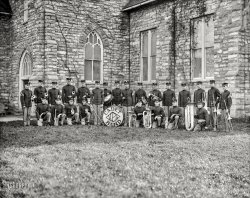
- It's Delovely! It's Dynamic!
- ... models. The lever coming out of the dashboard was on the 1955 cars. - Dave]
(ShorpyBlog, Member Gallery, Cars, Trucks, Buses, ... Posted by tterrace - 06/24/2009 - 5:10pm -
![It's Delovely! It's Dynamic! ...it's DeSoto! Specifically, a 1957 DeSoto. "This baby can flick its tail at anything on the road!" In this case, the Mar Monte Hotel in Santa Barbara in 1958. Detail from my brother-in-law's Anscochrome slide. Not his car, though. Full size.
The Most Exciting Car TodayIs now delighting the far highway ...
Nearly the same angleToday, from the hotel's website. Looks like they've done some remodeling and additions, but they've done a good job keeping it to the original style.
[Where are the tailfins? - Dave]
You Bet Your Life"Tell 'em Groucho sent ya!"
Looks familiarI thought, before reading the caption, that the hotel looked like it could be from around my home area. Sure enough... good ol' SB. Gotta love the red roof and the palm trees.
Jukebox DriveI remember Chrysler experimenting with ways to control its nifty, newfangled "Torqueflite" transmissions. The stick on the steering column and the floor shift were just so 1940's. I believe this baby had a short stick coming right out of the dash to select the gear. Our 1958 had a pod of lighted buttons on the dash labeled "P-R-N-D-2-L" hence the term "Jukebox" Drive. That "Firedome" V-8 could smoke the back wheels before you could push from "L" to "2". Ask me how I know. Mmmm, I forgot how much I loved that car.
[The transmission buttons on the '57 DeSoto were the same as on the 1958 models. The lever coming out of the dashboard was on the 1955 cars. - Dave]
(ShorpyBlog, Member Gallery, Cars, Trucks, Buses, tterrapix)](https://www.shorpy.com/files/images/sbdesoto.thumbnail.jpg)
- Nicollet Avenue: 1904
- ... J.C. Penney occupied the building from approximately 1955 through 1989. By then, its windows had long been covered by a long wall of ... Posted by Dave - 11/10/2017 - 6:41am -
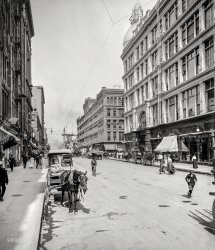
- Washington's Shadow: 1942
- ... 50s. When the Government finally tore them down circa 1955, my father, who was an FBI agent at the Washington Field Office in the Old ... Posted by Dave - 11/23/2020 - 3:22pm -
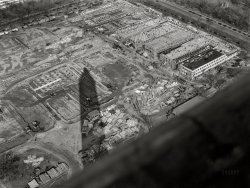
- Party Boat, US Navy in China: c. 1946
- ... signed by President Dwight D. Eisenhower, on August 9, 1955. Lieutenant Edward T. Lyon, ANC, became the first male Army nurse on October 6, 1955.
(ShorpyBlog, Member Gallery) ... Posted by citybeautiful - 09/19/2011 - 9:56pm -
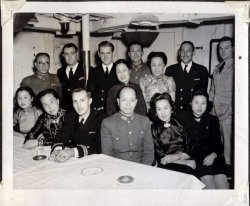
- There's Always Money: 1950
- ... around, though it has been Betty Ann's Dairy Freeze since 1955.
It looks a little forlorn in the street view, which shows it closed ... Posted by Dave - 06/09/2018 - 1:19pm -
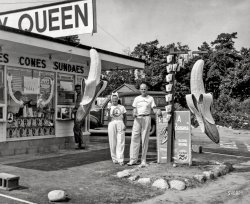
- Paging Mrs. Calabash: 1968
- ... last performance was on the Jimmy Durante show in 1955 and she began having the heart attack that would take her life just a few ... Posted by Dave - 06/07/2018 - 6:25pm -
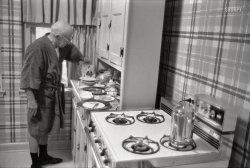
- The Imperial Twins: 1959
- ... rather not look under the Imperial. On a happier note, a 1955 Chevrolet. View full size.
Missouri is a good bet The Chevy in ... Posted by tterrace - 06/23/2018 - 6:38pm -
![The Imperial Twins: 1959 My sister-in-law Gimi's maternal grandmother and her identical twin pose with a 1958 Imperial in this Kodacolor print from July 1959. That's all we know for sure, although Gimi believes this is in the Ozarks of Missouri. Other elements give rise to speculation: the right taillight assembly suggests a close encounter with some native plant life, perhaps on a narrow, winding road that brought us hither. The pointing finger I like to think indicates a voice exclaiming "Get those saddle shoes OFF the Imperial!" As for the other orphan footwear, I just want to say I'd rather not look under the Imperial. On a happier note, a 1955 Chevrolet. View full size.
Missouri is a good betThe Chevy in back has a 1959 Missouri license plate.
Imperial DutyWhen I was a kid, I worked summers and weekends at a motel whose owner drove a giant Imperial much like this one. Washing and waxing that boat was an all-Saturday job; but I still had to find time to mow the grass!
Oh those wonderful tallightsChrysler folks nicknamed those taillamps "Sparrow Strainers". These might be referred to as "Shrub Strainers" though.
[It was "Uncle" Tom McCahill, not Chrysler, who coined the term. - Dave]
Uncle Tom McCahill!Thanks, Dave, for reminding us of this fine writer. He was the reason I subscribed to Mechanix Illustrated, and "Mail to McCahill" was the first thing I turned to when a new issue arrived. He could really turn a vivid phrase.
Uncle Tom had a special place in my heart for disputing Ralph Nader's contention that the fun and handsome Corvairs were unsafe. If my 1965 Corvair, "Ol' Paint," was unsafe, it was due to its manic teenaged driver!
Uncle TomThank you for reminding me of my old pal, Tom McCahill. As a young man intent on learning "everything" about automobiles, new and old, I turned to Roger Huntington for deep thinking and theory. But when it came to straight from the hip, no bull reporting, none but Uncle Tom was to be trusted. At least by me. If he said something wallowed in the turns or stopped like a mud flow, it was gospel.
I never learned it all, but those two gave me a decent base for my automobile knowledge.
(ShorpyBlog, Member Gallery, tterrapix)](https://www.shorpy.com/files/images/imperial_twins.thumbnail.jpg)
- Towers of the East: 1940
- ... Fair closed in 1940 but the Aquacade continued through 1955.
Dance of Life / Path of Darkness The titles of the bas-reliefs got ... Posted by returntoBuddha - 05/04/2015 - 7:17pm -
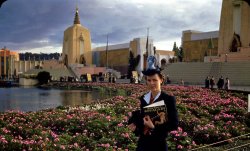
- Newspaper Row: 1905
- ... Those Buildings? The World Building was demolished in 1955 for the expanded car ramp entrance to the Brooklyn Bridge.
The Tribune ... Posted by Dave - 05/22/2019 - 7:41pm -
![Newspaper Row: 1905 New York circa 1905. "Newspaper Row -- City Hall Park." Headliners include the Tribune, Times and domed New York World (Pulitzer) buildings. 8x10 inch glass negative. View full size.
DetailOf the architectural variety. Something I miss in today's metal and glass facades. There's plenty to interest the eye in those buildings. I'm not an architect, but I prefer the older buildings. Here in Boston, there are still a few by H H Richardson and his disciples.
For what it's worth, I like the Tribune building the best. I would have loved to explore its upper floors and climb the tower.
And What Happened to Those Buildings?The World Building was demolished in 1955 for the expanded car ramp entrance to the Brooklyn Bridge.
The Tribune Building was torn down in 1966 to build One Pace Plaza, the central building of the Pace University campus, as part of the urban renewal project that included the World Trade Center.
After the New York Times relocated to Times Square in 1905, the former Times Building was renamed 41 Park Row and enlarged. Architect Robert Maynicke designed the alteration, which included the removal of the original mansard roof and the inclusion of two additional stories. Today, Pace University occupies the building.
Multi-StoriedWhen this photo was taken, the New York Tribune Building (at center) had just been "supersized" to the height shown here; before 1903 it was merely 10 floors tall. It was more than doubled in height in 1903-1905, reusing architectural elements of the original structure -- like the entire tower. At the extreme right, the red-brick Potter Building of 1883-1886 still stands after being converted from offices to apartments.
And I Raise Your BidSpeaking of enlarging the New York Tribune Building -- am I correct that in this 1905 photograph the World [Pultizer] Building is being enlarged? To me it looks as if the building is being nearly doubled in size on the back side. I cannot find a reference to a later addition … as if it matters now. But it makes me think that in 1905 there was competition afoot.
LookoutsIt appears there are people at the top of the dome. If so, I'd imagine the view was worth the climb.
(The Gallery, DPC, NYC)](https://www.shorpy.com/files/images/SHORPY-4a18575a.thumbnail.jpg)
- The Big Apple: 1936
- ... selected to film his "The Great Locomotive Chase" in 1955. The little road also had a bit part in the 1951 film "I'd Climb The ... Posted by Dave - 03/07/2018 - 10:14pm -
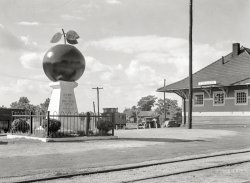
- Gray Saturday: 1951
- ... right in the center of town.
Wanamaker's was gone by 1955, but other department stores occupied its space for another 20 years. ... Posted by Dave - 12/26/2013 - 2:09pm -
![Gray Saturday: 1951 As an alternative to Black Friday, we present Gray Saturday. More specifically, the first day of December 62 years ago:
Dec. 1, 1951. "Shopping center, Great Neck, Long Island, New York. Wanamaker's." Large-format negative by Gottscho-Schleisner. View full size.
Dr. FuselageThe next-to-the-last car on the right (is that a Hudson?) brought back memories of my father, who was perfectly content to forgo the shopping experience and sit in the car, listening to the radio.
[It's a Nash. -tterrace]
Beautiful CarsAll those beautiful cars, with their magnificent chrome bumpers, lined-up at the curb in front of the store.
Garden of Great NeckJust over a year old in this picture, Garden of Great Neck was by some accounts the first suburban-style shopping plaza* in the New York metropolitan area. Definitions can be a bit fuzzy so it's hard to be certain. It's still a thriving center today, though of course it's been greatly renovated over the years. Great Neck is a very upscale community, and this center benefits from a prime location right in the center of town.
Wanamaker's was gone by 1955, but other department stores occupied its space for another 20 years. Today there's a supermarket on the lower level of the space, and if I'm not mistaken a fitness center occupies the upper part.
* shopping plaza is a much better term than that modern abomination "strip mall."
Great Neck today has a large Jewish population and a large Iranian population. While that sounds like a recipe for World War III, by all accounts everyone gets along fine.
Bathtub NashThe car to the left of the woody, to elaborate upon tterrace's identification.
(The Gallery, Cars, Trucks, Buses, Gottscho-Schleisner, Stores & Markets)](https://www.shorpy.com/files/images/SHORPY_5a20791u.thumbnail.jpg)
- Harris & Ewing: 1924
- ... bulk of which were donated to the Library of Congress in 1955. Harris & Ewing Collection glass negative. View full size.
... Posted by Dave - 08/28/2012 - 12:09pm -
![Harris & Ewing: 1924 Washington, D.C., circa 1924. "Harris & Ewing. Exterior, new studio." The new offices of "America's studio beautiful" opened in November 1924 at the same F Street address as the previous building (whose ground-floor tenant, Lucio's jewelry store, was the scene of a robbery/arson/suicide-by-cyanide shortly before the building was remodeled). The basement storage vault was said to have held a million glass negatives, the bulk of which were donated to the Library of Congress in 1955. Harris & Ewing Collection glass negative. View full size.
True CrimeWashington Post, May 26, 1924.
OPTICIAN DIES WHEN HELD
AS HE LEAVES BURNING GEM SHOP
Police Say Berman Had No Right in Store;
Suspect Robbery Aim
EXPLOSION CALLS POLICE TO SCENE
Doctor Discerned Walking About in
Flames and Smoke; Had Office There.
Dr. Lewis Berman, 36 years old, an optician, fell dead when placed under arrest early yesterday, a moment after he escaped from an explosion and fire which wrecked Lucio's jewelry store at 1313 F street NW.
Policemen Davis and Helms, of the First precinct, were standing at Fourteenth and F streets, about five minutes after 3 when an explosion occurred and the plate glass window of the jewelry store was shattered.
When they reached the store they found its exterior filled with flame and smoke through which they saw a man running back and forth. Davis called upon him to come out, but he was seen falling to the floor and crawling under a showcase. The policeman then brandished his revolver and threatened to fire, hoping to frighten the man into coming out.
Firemen Smash in Door.
A few moments later firemen smashed in the door with axes, and Dr. Berman ran out. As Policeman Davis arrested him, Dr. Berman told the officer, "I had a right to be in there." He repeated this several times, it is said, and then collapsed. When taken to Emergency hospital, he was pronounced dead.
Dr. Berman until Wednesday, it is said, had offices in the rear of the jewelry store. On that day he had sold out his interest to Mrs. Margaret Perkinson, who conducted the jewelry business.
Earl Perkinson, husband of the proprietor, was in the store until about 10:30 o'clock Saturday night. He placed diamonds and the receipts for two days' business in the safe, locked the store and left it.
Dr. Berman, according to police, occasionally went into the store, through courtesy, and had left there about 7 o'clock. Later in the evening he registered at a Turkish bath, but did not occupy his room there, police say. The next event was the explosion.
Police declare in their belief that an attempt was made to rob the store and a fire started to "cover up" the robbery. A duplicate key was found in Berman's pockets. He had no right to the key, police say.
Wife Can't Believe It.
When Mrs. Berman was informed of her husband's death by Mrs. Perkinson, she cried out, "Oh, I can't believe it, I can't believe it."
At the hospital she said that her husband probably, in passing the store, had seen burglars there and had entered to rout them.
Mrs. Berman has a daughter seven years old. The Berman residence is at the Home apartments, Seventh and K streets northwest.
An inquest will be held at 1:30 o'clock this afternoon to determine the cause of Dr. Berman's death. His clothing had not been burned, and it is thought he died from inhaling smoke and flames.
Washington Post, May 27, 1924.
BERMAN A SUICIDE, JURY ASSERTS;
GEM STORE SET ON FIRE
Optician Took Large Dose of Cyanide
Of Potassium, Chemist Finds.
PACKAGE OF JEWELRY MOVED NEAR DOOR
Wife Holds He Entered Shop to Get
Eyeglasses Left There for Repair.
A large dose of cyanide of potassium, self administered, caused the death of Dr. Lewis Berman, 36-year-old optician, who expired Sunday morning a moment after he had dashed out of the flame and smoke that enveloped Lucio's jewelry store, 1313 F street northwest.
This was the verdict yesterday of a coroner's jury which brought out these additional declarations:
The fire in Lucio's store was as was of incendiary origin.
Dr. Berman, who until Wednesday had rented space in the store, had no right in the store at that time of the morning, nor had he been authorized to have the key found in a pocket of his clothes.
The coroner's jury based its verdict of suicide on the testimony of Dr. S.C. Moton, assistant District chemist, who told of having found evidence is in the dead man's stomach of a large quantity of cyanide poisoning.
Police last night advanced the theory that Dr. Berman swallowed the poison the moment after he saw Policeman Davis at the door. It was pointed out that cyanide is a quick acting poison, and in view of the quantity taken, Berman could not have taken it much sooner.
None of the jewelry or other stock in the store was touched, so far as is known. A leather case left at the store by a Baltimore man, however, had been moved from a place behind the safe to a counter near the door. When it was placed behind the safe it was unwrapped. When found after the fire it was inclosed in newspapers and tied with heavy twine. The case contained watches and other jewelry.
Mrs. Berman, widow of the optician, at the inquest said: "I believe he wanted to get a pair of glasses which had been left for repairs by Abe Friedenberg."
Mr. Friedenberg, who lives at 3517 Fourteenth street northwest, concurred in this belief. He said that he had asked Dr. Berman to turn the glasses over to him before Sunday so that he would have them to read the Sunday newspapers.
Following the inquest yesterday, Dr. Berman's body was sent to Baltimore for burial.
America's Studio Beautiful
+86Below is the identical view taken in April of 2010. However, the occupant now deals in food instead of film.
Used to work in the buildingI worked in the building for 3 years. The 2nd - 4th floor of both buildings are now office space. When the previous tenant moved into 1313 F in the later 90s, they found a bunch of old negatives that belonged to Harris & Ewing.
[And did what with them?? - Dave]
(The Gallery, D.C., Harris + Ewing, Stores & Markets)](https://www.shorpy.com/files/images/17203a.thumbnail.jpg)
- The Senator: 1929
- ... Schedule this Here's the schedule for The Senator from 1955:
(The Gallery, D.C., Harris + Ewing, Politics, Railroads) ... Posted by Dave - 04/20/2013 - 8:53pm -
